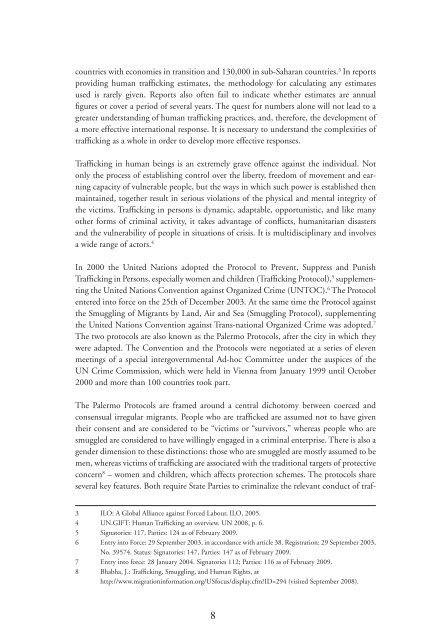Trafficking in human beings: human rights and ... - unesdoc - Unesco
Trafficking in human beings: human rights and ... - unesdoc - Unesco
Trafficking in human beings: human rights and ... - unesdoc - Unesco
You also want an ePaper? Increase the reach of your titles
YUMPU automatically turns print PDFs into web optimized ePapers that Google loves.
countries with economies <strong>in</strong> transition <strong>and</strong> 130,000 <strong>in</strong> sub-Saharan countries. 3 In reports<br />
provid<strong>in</strong>g <strong>human</strong> traffi ck<strong>in</strong>g estimates, the methodology for calculat<strong>in</strong>g any estimates<br />
used is rarely given. Reports also often fail to <strong>in</strong>dicate whether estimates are annual<br />
fi gures or cover a period of several years. The quest for numbers alone will not lead to a<br />
greater underst<strong>and</strong><strong>in</strong>g of <strong>human</strong> traffi ck<strong>in</strong>g practices, <strong>and</strong>, therefore, the development of<br />
a more effective <strong>in</strong>ternational response. It is necessary to underst<strong>and</strong> the complexities of<br />
traffi ck<strong>in</strong>g as a whole <strong>in</strong> order to develop more effective responses.<br />
Traffi ck<strong>in</strong>g <strong>in</strong> <strong>human</strong> be<strong>in</strong>gs is an extremely grave offence aga<strong>in</strong>st the <strong>in</strong>dividual. Not<br />
only the process of establish<strong>in</strong>g control over the liberty, freedom of movement <strong>and</strong> earn<strong>in</strong>g<br />
capacity of vulnerable people, but the ways <strong>in</strong> which such power is established then<br />
ma<strong>in</strong>ta<strong>in</strong>ed, together result <strong>in</strong> serious violations of the physical <strong>and</strong> mental <strong>in</strong>tegrity of<br />
the victims. Traffi ck<strong>in</strong>g <strong>in</strong> persons is dynamic, adaptable, opportunistic, <strong>and</strong> like many<br />
other forms of crim<strong>in</strong>al activity, it takes advantage of confl icts, <strong>human</strong>itarian disasters<br />
<strong>and</strong> the vulnerability of people <strong>in</strong> situations of crisis. It is multidiscipl<strong>in</strong>ary <strong>and</strong> <strong>in</strong>volves<br />
a wide range of actors. 4<br />
In 2000 the United Nations adopted the Protocol to Prevent, Suppress <strong>and</strong> Punish<br />
Traffi ck<strong>in</strong>g <strong>in</strong> Persons, especially women <strong>and</strong> children (Traffi ck<strong>in</strong>g Protocol), 5 supplement<strong>in</strong>g<br />
the United Nations Convention aga<strong>in</strong>st Organized Crime (UNTOC). 6 The Protocol<br />
entered <strong>in</strong>to force on the 25th of December 2003. At the same time the Protocol aga<strong>in</strong>st<br />
the Smuggl<strong>in</strong>g of Migrants by L<strong>and</strong>, Air <strong>and</strong> Sea (Smuggl<strong>in</strong>g Protocol), supplement<strong>in</strong>g<br />
the United Nations Convention aga<strong>in</strong>st Trans-national Organized Crime was adopted. 7<br />
The two protocols are also known as the Palermo Protocols, after the city <strong>in</strong> which they<br />
were adapted. The Convention <strong>and</strong> the Protocols were negotiated at a series of eleven<br />
meet<strong>in</strong>gs of a special <strong>in</strong>tergovernmental Ad-hoc Committee under the auspices of the<br />
UN Crime Commission, which were held <strong>in</strong> Vienna from January 1999 until October<br />
2000 <strong>and</strong> more than 100 countries took part.<br />
The Palermo Protocols are framed around a central dichotomy between coerced <strong>and</strong><br />
consensual irregular migrants. People who are traffi cked are assumed not to have given<br />
their consent <strong>and</strong> are considered to be “victims or “survivors,” whereas people who are<br />
smuggled are considered to have will<strong>in</strong>gly engaged <strong>in</strong> a crim<strong>in</strong>al enterprise. There is also a<br />
gender dimension to these dist<strong>in</strong>ctions: those who are smuggled are mostly assumed to be<br />
men, whereas victims of traffi ck<strong>in</strong>g are associated with the traditional targets of protective<br />
concern 8 – women <strong>and</strong> children, which affects protection schemes. The protocols share<br />
several key features. Both require State Parties to crim<strong>in</strong>alize the relevant conduct of traf-<br />
3 ILO: A Global Alliance aga<strong>in</strong>st Forced Labour, ILO, 2005.<br />
4 UN.GIFT: Human Traffi ck<strong>in</strong>g an overview. UN 2008, p. 6.<br />
5 Signatories: 117, Parties: 124 as of February 2009.<br />
6 Entry <strong>in</strong>to Force: 29 September 2003, <strong>in</strong> accordance with article 38. Registration: 29 September 2003,<br />
No. 39574. Status: Signatories: 147, Parties: 147 as of February 2009.<br />
7 Entry <strong>in</strong>to force: 28 January 2004. Signatories 112; Parties: 116 as of February 2009.<br />
8 Bhabha, J.: Traffi ck<strong>in</strong>g, Smuggl<strong>in</strong>g, <strong>and</strong> Human Rights, at<br />
http://www.migration<strong>in</strong>formation.org/USfocus/display.cfm?ID=294 (visited September 2008).<br />
8

















